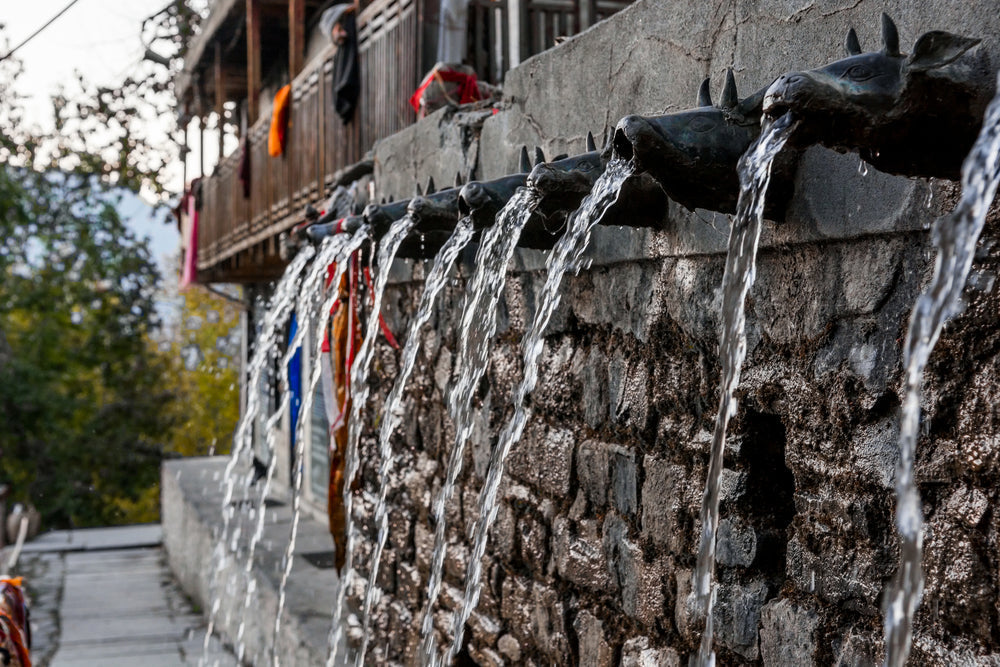
The Sacred Waters of Muktinath
Share
High in the rugged folds of the Himalayas, where the earth kisses the sky and time feels suspended in the cool mountain air, lies Muktinath—a sacred sanctuary revered by both Hindus and Buddhists. Nestled at an altitude of 3,800 meters in Nepal’s Mustang district, Muktinath is not just a temple. It is a place where faith flows freely, both in prayer and through its famous waters.
Where Earth Meets the Divine
Muktinath, which means “Place of Liberation,” is believed by Hindus to be a Moksha Dham—one of the holiest places on earth to achieve spiritual freedom. For Buddhists, it’s a site of profound pilgrimage, where the tantric master Padmasambhava meditated on his way to Tibet, infusing the landscape with sacred energy.
But beyond the ornate temple structure and the fluttering prayer flags is a phenomenon that binds both belief systems: the 108 waterspouts that line the temple courtyard and the eternal flame that burns alongside a spring.

The 108 Waterspouts: Bathing in Blessing
Pilgrims come from across the globe to bathe under the freezing gush of the 108 muktidhara (water spouts), each carved in the shape of a cow’s head. These spouts are fed by glacial meltwater from the Dhaulagiri range, and it is believed that bathing under each one purifies the body and soul, washing away the sins of past lives.
For many, this act is not simply symbolic. Despite the biting chill, devotees move from spout to spout with unwavering devotion—some chanting, others weeping—each drop of water a step toward inner liberation.
The number 108 holds sacred significance in both Hinduism and Buddhism. It symbolizes completeness in spiritual practice—there are 108 beads in a mala, 108 names of deities, and 108 sacred texts. Bathing in all 108 spouts is believed to align the body’s energy with the universe, bringing harmony, clarity, and peace.

The Eternal Flame: Earth, Water, and Fire United
Within the temple complex lies another marvel—the Jwala Mai shrine. Here, a natural gas flame burns eternally atop a trickling spring, symbolizing the rare convergence of fire and water. This eternal flame, burning unbroken for centuries, is seen as a manifestation of divine presence, representing both transformation and constancy.
Pilgrims light butter lamps and offer prayers to the flame, seeking healing and blessings. The duality of water and fire—cleansing and energy, softness and strength—embodies the balance that seekers come to Muktinath to find.

More Than a Destination—A Pilgrimage Within
Reaching Muktinath is no easy feat. Whether by foot, horseback, or four-wheel drive through the windswept Kali Gandaki valley, the journey is part of the pilgrimage. Treacherous roads, thin air, and unpredictable weather test not just physical endurance but faith itself.
Yet, for those who make it, the reward is more than panoramic views or historic architecture. It’s a quiet moment under a spout of icy water. It’s the realization that liberation might not come with a lightning bolt of enlightenment, but in the steady surrender of ego, one drop at a time.

Final Thoughts
The sacred waters of Muktinath don’t just cleanse—they awaken. In a world where we often seek answers in speed, Muktinath invites stillness. In the rhythmic pour of its sacred waters, many hear a truth they had long forgotten: that healing is found not in escape, but in return—to the self, to the source, to something greater than ourselves.
Whether you go for the myth, the adventure, or the miracle, Muktinath leaves a mark. Not just on your skin, cold from glacier-fed streams—but on your spirit, refreshed and renewed.


